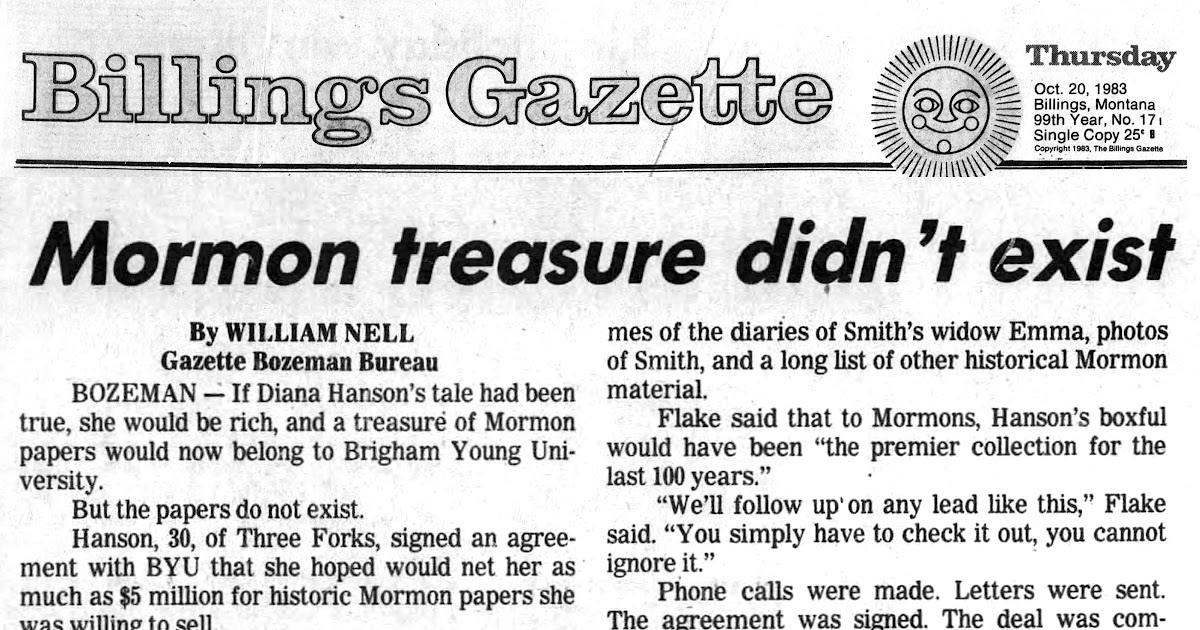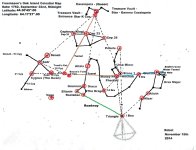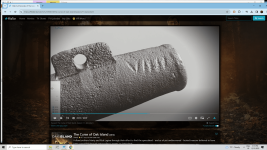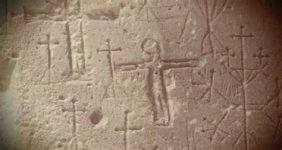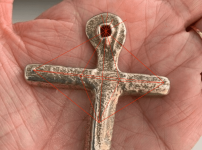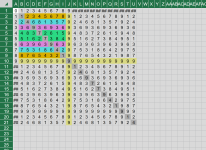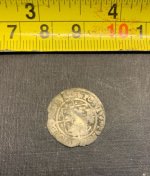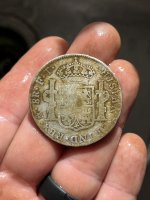Templars indeed.What has preceded could be mere happenstance, but the suggested ground plan does receive potential support from another direction. The point is, just how likely is it that this could happen should the ground plan be pure conjecture and should the data it’s being matched to be pure fiction.
What might be the odds against this happening, that is, finding order when applying claimed fictional directions to an equally fictional ground plan? Sensibly, it just shouldn’t happen.
In this, I would simply ask the reader to suspend disbelief and assess what is being presented in a truly objective manner. By all means bear in mind that the ground plan may not be what the originator drew up and that the directions employed could have been fabricated, but ask yourself how on earth the result of the process described could be achieved were this so.
Assume that you need to identify locations on the ground by reference to five ground markers positioned using a dreamed up geometrical schema. The five points could be anywhere on a plot of land 420 feet by 480 feet. Put them wherever you want.
Now, conjure up five sets of instructions out of thin air employing between five and eight random numbers with the same number of random bearings as offsets from three of the five points on the ground. Then, draw a figure on the ground and interpreting the instructions in the same way make them end up positioned equally-spaced on that figure.
What’s the likelihood that you could achieve that in one go and would you reasonably expect that to happen? What’s the likelihood that you could do it in a thousand goes? I suggest that your winning the lottery, should you enter, would be far more likely. Bear in mind that everything is random because the entire basis is fictional.
That’s what many might consider we have on Oak Island. I’ve drawn up what many would consider a fictional ground plan and now I intend to apply five sets of widely-assumed fictional instructions to it. The aim is to match these to five out of seven equally-spaced points on the Rhombus Rectangle that emerged quite naturally and geometrically from the ground plan I developed based on the placing of the ground markers on Oak Island.
Of course, the directions I’m talking about are the instructions on five much-derided treasure maps - and note well only the instructions, not the outline of the island. I’ve previously observed that these instructions when interpreted in exactly the same way using the ground plan developed in the preceding posts lead to five of the seven points marked on the Rhombus Rectangle.
I’m amazed that this could happen by sheer accident, but it seems that I’m the only person who is! I assume that this is because people have decided that they don’t believe in treasure maps. Treasure hunters who don’t concede the possibility of there having been treasure maps? Could it be?
I’ve noted that it seems that clues are being intentionally left by the originator, and there’s a clue to the working of the instructions provided on one of the maps. The text reads, “from centre of triangle between Rocks,” followed by a distance (20 feet) and a bearing (East). This actually leads to the point on the Rhombus designated 'F' and is short of target by just 7 inches.
However, this immediately opens up the remaining sets of instructions. They all work in the same way:
Identify three points by distance and bearing from the ground markers identified: the drilled rocks, triangle or Tree (Money Pit). Form a triangle and find its centre (by median). Then take an offset as specified in the direction of the Rock Centre Point unless stated otherwise. Should a unit be specified in the offset on the last line in the form “a by b by c” then resolve this as “a + b + ac”.
This is why “3 feet by 3 feet by FOUR” resolves to 18 feet, “7 feet by 7 feet by 8" is 70 feet and “5 feet by 4 feet by 5" is 34 feet.
So, the instructions given in an earlier post would read: From a point on the Roadway at the west of the island go 515 fathoms southeast (to the Welling Triangle) and then 50 fathoms north (to the Tree, or Money Pit) and then 36 fathoms in the direction of the East Rock which is then 36 fathoms from this spot. Form a triangle with the two rocks and find its centre and continue 18 feet (north) from there. The end point is a mere five inches short of the target (the Rhombus point designated 'D').
That this could be done once with purely random distances and random bearings from a fictional map based on a fictional ground plan is surprising to me, but to be able to do it five times is almost unbelievable.
Unfortunately, the maps have not been well received and there’s a tendency to write off the instructions along with the outline of the island and the pieces of paper. These may well be copies of copies of copies, and the island outline looks little like Oak Island, but this should have no bearing on the validity or application of the instructions.
I fully appreciate that if you’ve decided the treasure is in the Money Pit and you desperately want the originator to be Templar then this is not for you.
The same divinely dedicated and constructive group that sacked the Holy Land of antiquities/treasures. Built and engineered structures, fortresses, castles and churches across Europe all the way to the Holy Land. When outlawed there would be no shortage of Templar volunteers with the requisite skills to travel to the end of the earth(at that time) and work on this 'final crusade'.
Treasure?, Antiquities?, Pestilence?, Pure Evil? Whatever it is , it was never meant to be found, the Templars knew the game was over for them.
The carved rocks on Oak Island were the "Kilroy Was Here" graffiti of the era, the "off hour" activities of the talented work crew. Lining up large rocks might have even been the effort of a few subversives to geo-locate the shaft when they returned at a later time. If the Templars didn't 'off' them after the project... for sure death awaited everyone upon return to Europe anyway.
Gold, brass, bronze & metals in the water sounds interesting no matter what it is.


